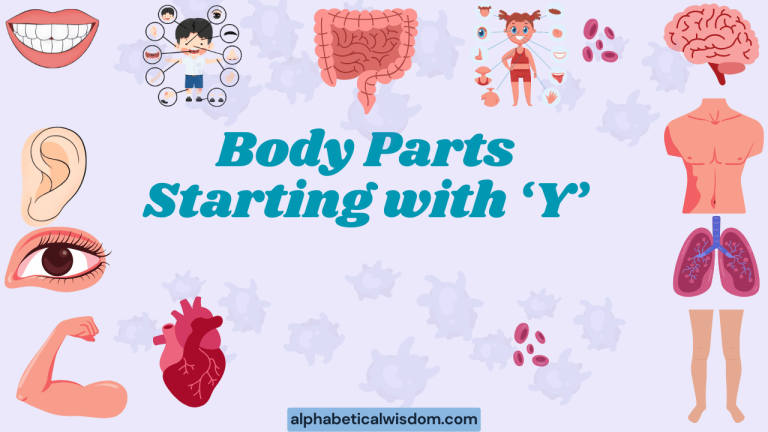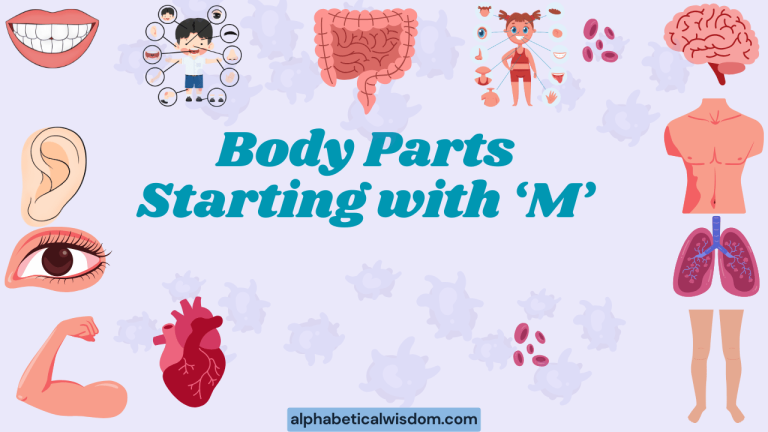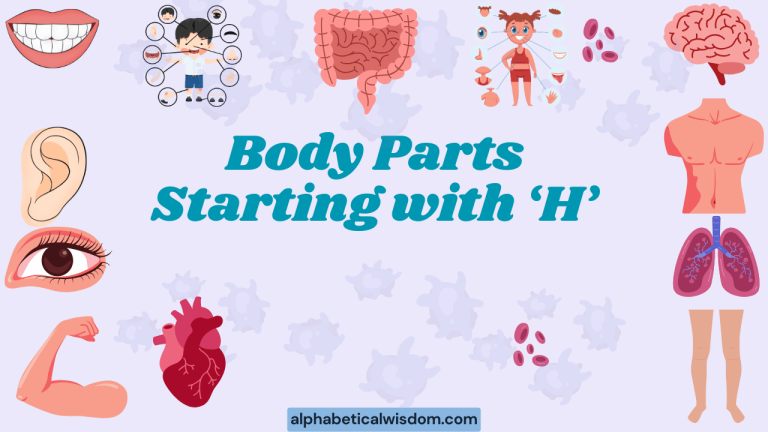Body Parts Starting with K: A Comprehensive Grammar Guide
Understanding the specific usage of body parts starting with the letter ‘k’ in English is crucial for precise communication, especially in medical, anatomical, and everyday contexts. While the list is short, the proper usage of these terms enhances clarity and avoids potential misunderstandings.
This guide covers the relevant body parts, their definitions, grammatical roles, and common mistakes, providing a solid foundation for both native and non-native English speakers looking to improve their anatomical vocabulary and grammatical accuracy.
This article will benefit students, medical professionals, writers, and anyone interested in learning more about English grammar and vocabulary related to human anatomy. By the end of this guide, you will be able to confidently use these terms in various contexts, avoiding common errors and improving your overall language proficiency.
Table of Contents
- Introduction
- Definition of Body Parts Starting with K
- Structural Breakdown
- Types or Categories
- Examples
- Usage Rules
- Common Mistakes
- Practice Exercises
- Advanced Topics
- FAQ
- Conclusion
Definition of Body Parts Starting with K
In the English language, when discussing body parts that begin with the letter ‘k’, two primary terms come to mind: kidney and knee. Each term refers to a distinct and vital part of the human anatomy. Understanding their specific functions and grammatical usage is crucial for both general knowledge and effective communication in medical and everyday contexts.
Kidney
A kidney is one of a pair of bean-shaped organs located in the abdominal cavity. Its primary function is to filter waste products from the blood and regulate the body’s fluid and electrolyte balance. The kidneys produce urine, which carries these waste products out of the body. They also play a role in regulating blood pressure and producing hormones. The word “kidney” is a noun, and it can be used in both singular and plural forms (“kidney” and “kidneys,” respectively). It can also be used attributively, as in “kidney disease” or “kidney failure.”
The kidneys are essential for maintaining overall health and homeostasis. They are constantly working to ensure the body has the right balance of fluids and electrolytes.
Any damage or dysfunction of the kidneys can have serious consequences, requiring medical intervention such as dialysis or kidney transplant.
Knee
The knee is a complex hinge joint that connects the thigh (femur) to the lower leg (tibia and fibula). It allows for flexion and extension, enabling activities such as walking, running, and jumping. The knee joint is stabilized by ligaments, tendons, and muscles. The word “knee” is a noun, and it can be used in both singular and plural forms (“knee” and “knees,” respectively). It can also be used attributively, as in “knee surgery” or “knee pain.”
The knee is a vulnerable joint, susceptible to injury from trauma, overuse, or arthritis. Common knee problems include ligament tears, meniscus injuries, and osteoarthritis.
Treatment options range from conservative measures like physical therapy and pain medication to surgical interventions like arthroscopy or knee replacement.
Structural Breakdown
A deeper understanding of the anatomy and structure of the kidney and knee provides a valuable context for their functions and potential issues. This section breaks down the key structural elements of each body part.
Kidney Structure
Each kidney is approximately 12 cm long, 6 cm wide, and 3 cm thick, weighing about 150 grams. The kidney is divided into several key regions:
- Renal Cortex: The outer region of the kidney, containing the glomeruli and tubules responsible for filtering blood.
- Renal Medulla: The inner region of the kidney, consisting of cone-shaped structures called renal pyramids. These pyramids contain the collecting ducts that carry urine to the renal pelvis.
- Renal Pelvis: A funnel-shaped structure that collects urine from the renal pyramids and drains it into the ureter.
- Nephron: The functional unit of the kidney, responsible for filtering blood and producing urine. Each kidney contains about one million nephrons.
The nephron itself is composed of the glomerulus, Bowman’s capsule, proximal tubule, loop of Henle, distal tubule, and collecting duct. Each part plays a critical role in the filtration and reabsorption processes that produce urine.
Knee Structure
The knee joint is a complex structure involving several bones, ligaments, and other tissues:
- Femur: The thigh bone, which forms the upper part of the knee joint.
- Tibia: The shin bone, which forms the lower part of the knee joint.
- Fibula: A smaller bone located alongside the tibia, which does not directly articulate with the femur but contributes to ankle stability.
- Patella: The kneecap, a small bone that sits in front of the knee joint and protects it.
- Ligaments: Strong bands of tissue that connect bones and provide stability to the knee joint. Key ligaments include the anterior cruciate ligament (ACL), posterior cruciate ligament (PCL), medial collateral ligament (MCL), and lateral collateral ligament (LCL).
- Meniscus: Two C-shaped pieces of cartilage that act as shock absorbers between the femur and tibia.
- Cartilage: A smooth, slippery tissue that covers the ends of the bones in the knee joint, allowing them to move easily against each other.
The knee joint is also surrounded by muscles, tendons, and bursae (fluid-filled sacs that cushion the joint). These structures work together to provide movement, stability, and protection to the knee.
Types or Categories
Understanding the categories of conditions and injuries associated with kidneys and knees provides a more comprehensive understanding of their importance in maintaining overall health.
Kidney Conditions
Kidney conditions can be broadly categorized into several types:
- Chronic Kidney Disease (CKD): A progressive loss of kidney function over time.
- Acute Kidney Injury (AKI): A sudden loss of kidney function, often caused by illness, injury, or medications.
- Kidney Stones: Hard deposits that form in the kidneys from minerals and salts.
- Glomerulonephritis: Inflammation of the glomeruli, the filtering units of the kidneys.
- Polycystic Kidney Disease (PKD): An inherited disorder in which cysts develop in the kidneys.
- Kidney Cancer: Cancer that originates in the kidneys.
- Urinary Tract Infections (UTIs): Infections that can affect the kidneys, bladder, and other parts of the urinary system.
Each of these conditions can have different causes, symptoms, and treatments. Early diagnosis and management are crucial for preventing complications and preserving kidney function.
Knee Injuries
Knee injuries can be categorized based on the affected structure and the mechanism of injury:
- Ligament Injuries: Tears or sprains of the ACL, PCL, MCL, or LCL.
- Meniscus Tears: Tears in the cartilage that cushions the knee joint.
- Fractures: Breaks in the bones of the knee, such as the femur, tibia, or patella.
- Dislocations: Displacement of the patella or other bones in the knee joint.
- Tendonitis: Inflammation of the tendons around the knee, such as the patellar tendon.
- Bursitis: Inflammation of the bursae (fluid-filled sacs) around the knee.
- Osteoarthritis: Degeneration of the cartilage in the knee joint.
The severity of knee injuries can range from mild sprains to severe tears or fractures, requiring different treatment approaches. Proper diagnosis and rehabilitation are essential for restoring knee function and preventing long-term problems.
Examples
This section provides numerous examples of how the words “kidney” and “knee” are used in sentences, demonstrating their grammatical roles and contextual meanings.
Kidney Examples
The following table presents examples of how “kidney” and “kidneys” are used in various sentences, showcasing different grammatical contexts. These examples cover singular and plural forms, as well as attributive usages.
| Sentence | Grammatical Role | Context |
|---|---|---|
| The doctor ordered a kidney function test. | Noun, singular | Medical examination |
| Kidney disease can lead to serious health problems. | Noun, attributive | Medical condition |
| She donated a kidney to her brother. | Noun, singular | Organ donation |
| The patient’s kidneys were failing. | Noun, plural | Medical condition |
| Kidneys filter waste products from the blood. | Noun, plural | Anatomical function |
| He suffered from kidney stones. | Noun, attributive | Medical condition |
| The transplant team assessed the donor’s kidney. | Noun, singular | Medical procedure |
| Kidney failure requires dialysis or a transplant. | Noun, attributive | Medical treatment |
| The medication can affect the kidneys. | Noun, plural | Side effect |
| A healthy diet is important for kidney health. | Noun, attributive | Preventative care |
| The surgeon removed the damaged kidney. | Noun, singular | Surgical procedure |
| Kidney infections can be very painful. | Noun, attributive | Medical condition |
| The study focused on the effects of pollution on the kidneys. | Noun, plural | Scientific research |
| He was born with only one kidney. | Noun, singular | Congenital condition |
| The kidneys regulate blood pressure. | Noun, plural | Physiological function |
| She experienced kidney pain after the accident. | Noun, attributive | Medical symptom |
| The doctor explained the importance of maintaining healthy kidneys. | Noun, plural | Medical advice |
| Kidney dialysis helps filter the blood when the kidneys fail. | Noun, attributive | Medical treatment |
| The new drug showed promise in treating kidney disease. | Noun, attributive | Medical research |
| The patient’s kidney function improved after the treatment. | Noun, singular | Medical outcome |
| The autopsy revealed damage to the kidneys. | Noun, plural | Medical examination |
| Kidney transplantation can significantly improve the quality of life for patients with kidney failure. | Noun, attributive | Medical procedure |
| The research team investigated the role of genes in kidney development. | Noun, attributive | Scientific research |
| He decided to donate his kidney after learning about his friend’s condition. | Noun, singular | Organ donation |
Knee Examples
The following table presents examples of how “knee” and “knees” are used in various sentences, showcasing different grammatical contexts. These examples cover singular and plural forms, as well as attributive usages.
| Sentence | Grammatical Role | Context |
|---|---|---|
| He injured his knee playing soccer. | Noun, singular | Sports injury |
| Knee surgery is often required for severe injuries. | Noun, attributive | Medical procedure |
| She bent her knees to pick up the box. | Noun, plural | Physical action |
| The athlete’s knees were strong and flexible. | Noun, plural | Physical attribute |
| He felt pain in his knee after the fall. | Noun, singular | Physical sensation |
| Knee pain can be debilitating. | Noun, attributive | Medical symptom |
| The doctor examined her knee. | Noun, singular | Medical examination |
| Knee replacement is a common procedure for osteoarthritis. | Noun, attributive | Medical treatment |
| She rested her knees on the pillow. | Noun, plural | Physical position |
| His knees were shaking with fear. | Noun, plural | Emotional response |
| The dancer’s knee gave way during the performance. | Noun, singular | Physical failure |
| Knee braces can provide support and stability. | Noun, attributive | Medical aid |
| He knelt down on his knee to propose. | Noun, singular | Social custom |
| Her knees ached after the long hike. | Noun, plural | Physical discomfort |
| The surgeon specialized in knee injuries. | Noun, attributive | Medical specialization |
| The child scraped his knee while playing. | Noun, singular | Minor injury |
| Knee exercises can help strengthen the muscles around the joint. | Noun, attributive | Physical therapy |
| She wrapped a bandage around her injured knee. | Noun, singular | First aid |
| The robot had articulated knees. | Noun, plural | Technological design |
| The old man’s knees creaked when he walked. | Noun, plural | Physical sign of aging |
| The physical therapist recommended specific knee strengthening exercises. | Noun, attributive | Medical advice |
| She applied ice to her swollen knee after the game. | Noun, singular | Post-activity care |
| The doctor explained the risks and benefits of knee arthroscopy. | Noun, attributive | Medical procedure |
| His knees buckled under the weight of the heavy load. | Noun, plural | Physical strain |
| The athlete wore knee pads for protection during the competition. | Noun, attributive | Protective gear |
Usage Rules
Understanding the specific rules for using “kidney” and “knee” helps to ensure grammatical accuracy and clarity in communication. This section outlines these rules, including exceptions and special cases.
Kidney Usage Rules
The word “kidney” functions primarily as a noun. Here are the key rules governing its usage:
- Singular vs. Plural: Use “kidney” to refer to one kidney and “kidneys” to refer to both.
- Attributive Use: “Kidney” can be used as an adjective to modify other nouns, such as “kidney disease” or “kidney failure.”
- Countable Noun: “Kidney” is a countable noun, meaning it can be counted and used with articles (a, an, the) and numbers. For example: “a kidney,” “one kidney,” “two kidneys.”
- With Verbs: When using “kidney” as the subject of a sentence, the verb must agree in number. For example: “The kidney filters blood” (singular) vs. “The kidneys filter blood” (plural).
There are no significant exceptions to these rules. However, context is important.
In medical contexts, specific terminology may be used, such as “renal” (related to the kidney), but the basic rules of grammar still apply.
Knee Usage Rules
The word “knee” also functions primarily as a noun. Here are the key rules governing its usage:
- Singular vs. Plural: Use “knee” to refer to one knee and “knees” to refer to both.
- Attributive Use: “Knee” can be used as an adjective to modify other nouns, such as “knee surgery” or “knee pain.”
- Countable Noun: “Knee” is a countable noun, meaning it can be counted and used with articles (a, an, the) and numbers. For example: “a knee,” “one knee,” “two knees.”
- With Verbs: When using “knee” as the subject of a sentence, the verb must agree in number. For example: “The knee bends easily” (singular) vs. “The knees bend easily” (plural).
- Idiomatic Expressions: “Knee” appears in several idiomatic expressions, such as “weak at the knees” (feeling faint or nervous) and “bring someone to their knees” (to defeat or humble someone). In these expressions, the grammatical rules remain the same, but the meaning is figurative.
Again, there are no significant exceptions to these rules. However, in certain contexts, “knee” can be used metaphorically, as in “the knee of the curve,” referring to a point where a graph sharply changes direction.
Common Mistakes
Even with a good understanding of the rules, some common mistakes can occur when using “kidney” and “knee.” This section highlights these errors and provides correct alternatives.
Kidney Mistakes
Here are some common mistakes when using “kidney”:
| Incorrect | Correct | Explanation |
|---|---|---|
| The kidneys is important for filtering blood. | The kidneys are important for filtering blood. | Verb agreement error. “Kidneys” is plural, so the verb should be “are.” |
| He had a kidney’s infection. | He had a kidney infection. | Incorrect use of the possessive form. “Kidney” is used attributively here, not possessively. |
| She has kidney problem. | She has a kidney problem. | Missing article. “Kidney problem” is a countable noun and requires an article. |
| The doctor checked her kidney’s function. | The doctor checked her kidney function. | Incorrect use of the possessive form. “Kidney” is used attributively here. |
| Both of his kidney failed. | Both of his kidneys failed. | Incorrect use of the singular form when referring to both kidneys. |
Knee Mistakes
Here are some common mistakes when using “knee”:
| Incorrect | Correct | Explanation |
|---|---|---|
| Her knee are swollen. | Her knees are swollen. | Subject-verb agreement error. “Knees” is plural. |
| He has knee’s pain. | He has knee pain. | Incorrect use of the possessive form. “Knee” is used attributively. |
| She injured knee in the game. | She injured her knee in the game. | Missing article and possessive pronoun. |
| The doctor examined knee’s joint. | The doctor examined the knee joint. | Incorrect use of the possessive form. “Knee” is used attributively. |
| His both knee hurt. | Both of his knees hurt. | Incorrect word order and singular form when referring to both knees. |
Practice Exercises
These exercises will help you practice using “kidney” and “knee” correctly in sentences. Each exercise focuses on different aspects of their usage, including singular and plural forms, attributive use, and verb agreement.
Kidney Exercises
Instructions: Fill in the blanks with the correct form of “kidney” (kidney or kidneys).
| Question | Answer |
|---|---|
| 1. The main function of the _________ is to filter blood. | kidney |
| 2. _________ disease can be caused by diabetes. | Kidney |
| 3. He donated one of his _________ to his sister. | kidneys |
| 4. The doctor ordered a _________ function test. | kidney |
| 5. _________ play a vital role in maintaining electrolyte balance. | Kidneys |
| 6. _________ stones can cause severe pain. | Kidney |
| 7. The patient’s _________ were not functioning properly. | kidneys |
| 8. _________ failure requires immediate medical attention. | Kidney |
| 9. She is on dialysis because her _________ have failed. | kidneys |
| 10. A healthy lifestyle is essential for _________ health. | kidney |
Knee Exercises
Instructions: Fill in the blanks with the correct form of “knee” (knee or knees).
| Question | Answer |
|---|---|
| 1. He injured his _________ playing basketball. | knee |
| 2. _________ surgery is a common procedure for athletes. | Knee |
| 3. She bent her _________ to pick up the child. | knees |
| 4. _________ pain can be a sign of arthritis. | Knee |
| 5. The doctor examined his _________ for signs of injury. | knee |
| 6. _________ replacement surgery can relieve chronic pain. | Knee |
| 7. He rested his _________ on the soft cushion. | knees |
| 8. Her _________ were shaking with nervousness. | knees |
| 9. The athlete wore a _________ brace for support. | knee |
| 10. He knelt down on one _________ to propose marriage. | knee |
Advanced Topics
For advanced learners, exploring more complex aspects of “kidney” and “knee” can provide a deeper understanding of their roles in the human body and related medical fields.
Advanced Kidney Terminology
Advanced topics related to the kidney include understanding complex medical terminology and physiological processes. For example:
- Glomerular Filtration Rate (GFR): A measure of how well the kidneys are filtering blood.
- Electrolyte Imbalance: Disruptions in the levels of essential minerals like sodium, potassium, and calcium, often regulated by the kidneys.
- Renin-Angiotensin-Aldosterone System (RAAS): A hormonal system that regulates blood pressure and fluid balance, involving the kidneys.
- Diuretics: Medications that increase urine production, often used to treat high blood pressure and fluid retention.
Understanding these concepts requires a solid foundation in biology and medicine. Further research and study are recommended for those interested in pursuing these topics.
Advanced Knee Biomechanics
Advanced topics related to the knee include understanding the biomechanics of the joint and complex surgical procedures. For example:
- Kinematics of the Knee: The study of the motion of the knee joint, including flexion, extension, rotation, and translation.
- Ligament Reconstruction: Surgical procedures to repair or replace torn ligaments in the knee, such as the ACL.
- Meniscal Transplantation: A procedure to replace damaged or missing meniscus cartilage with a donor meniscus.
- Total Knee Arthroplasty (TKA): A surgical procedure to replace the entire knee joint with artificial components.
These topics require a strong understanding of anatomy, biomechanics, and surgical techniques. Medical professionals and researchers often delve into these areas to improve treatment outcomes and develop new technologies.
FAQ
This section addresses frequently asked questions about the usage of “kidney” and “knee,” providing clear and concise answers to common queries.
- Is “kidney” a countable or uncountable noun?
“Kidney” is a countable noun. You can have one kidney, two kidneys, or several kidneys. Therefore, it can be used with articles (a, an, the) and numbers. - Can “knee” be used as a verb?
While “knee” is primarily used as a noun, it can be used as a verb, although less commonly. For example, “He kneed the attacker in the groin.” In this case, “kneed” means to strike with the knee. - What is the difference between “renal” and “kidney”?
“Renal” is an adjective that means “relating to the kidneys.” For example, “renal failure” means kidney failure. “Kidney” is the noun referring to the organ itself. - What are some common idioms that use the word “knee”?
Some common idioms include: “weak at the knees” (feeling faint or nervous), “bring someone to their knees” (to defeat or humble someone), and “a bee’s knees” (excellent). - How do you use “kidney” attributively?
When used attributively, “kidney” acts as an adjective to describe another noun. For example, “kidney disease,” “kidney transplant,” and “kidney failure.” - What is the correct plural form of “knee”?
The correct plural form of “knee” is “knees.” - When should I use “kidney” vs. “kidneys” in a sentence?
Use “kidney” when referring to a single kidney. Use “kidneys” when referring to both kidneys or multiple kidneys. For example, “The kidney filters blood” (singular) vs. “The kidneys filter blood” (plural). - Are there any irregular plural forms for “kidney” or “knee”?
No, both “kidney” and “knee” have regular plural forms: “kidneys” and “knees,” respectively. There are no irregular plural forms to worry about. - How does subject-verb agreement apply to “kidney” and “knee”?
The verb must agree in number with the subject. For example: “The kidney filters blood” (singular) and “The kidneys filter blood” (plural). Similarly, “The knee bends easily” (singular) and “The knees bend easily” (plural). - Can you use “kidney” or “knee” in a possessive form?
Yes, you can use them in a possessive form. For example, “the kidney’s function” or “the knee’s range of motion.” However, be careful not to confuse this with attributive use, where the possessive form is not needed.
Conclusion
Mastering the correct usage of body part nouns like “kidney” and “knee” is vital for clear communication, whether in general conversations, medical contexts, or academic writing. This comprehensive guide has covered the definitions, structural breakdowns, types, examples, usage rules, common mistakes, and advanced topics related to these terms.
By understanding these concepts, you can significantly improve your English grammar and vocabulary skills.
Remember to practice using these terms in various contexts to solidify your understanding. Pay attention to subject-verb agreement, singular and plural forms, and attributive usage.
By avoiding common mistakes and continuously refining your knowledge, you can confidently use “kidney” and “knee” in your everyday language. Continued learning and practice are key to mastering the nuances of English grammar and expanding your vocabulary.






